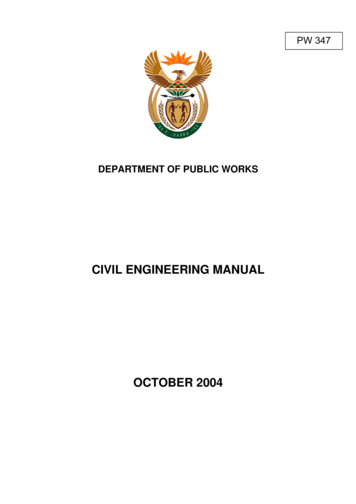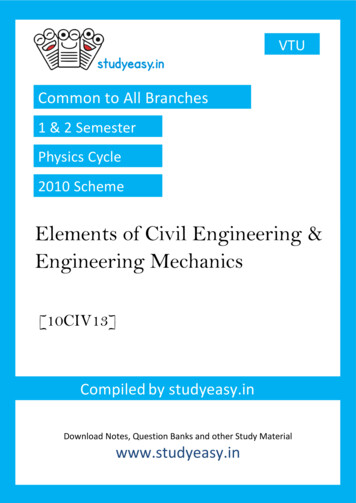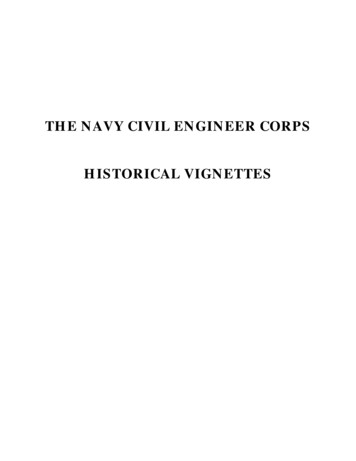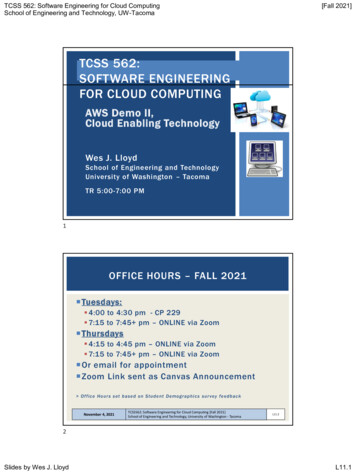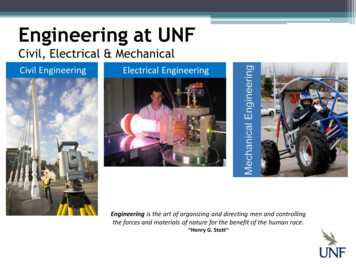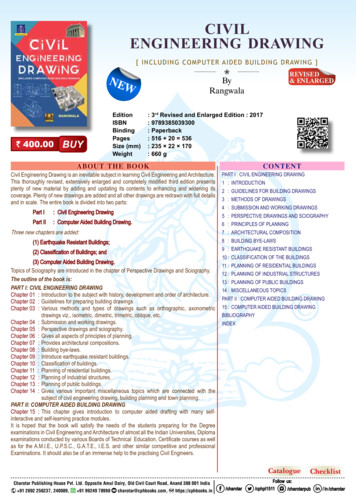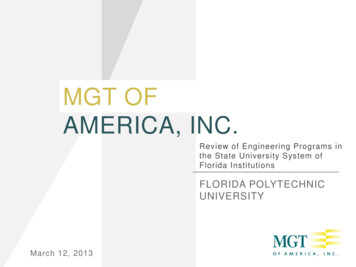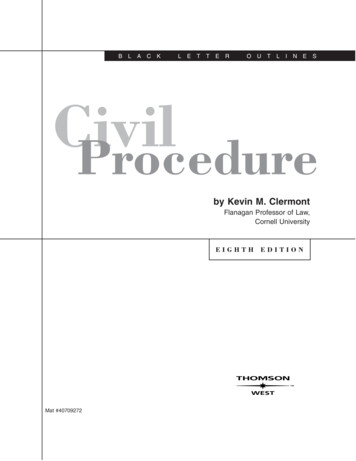
Transcription
CIVL 1101What is Civil Engineering?What is Civil Engineering?Civil Engineering:The Past, Present, and FutureWhat is Civil Engineering?Civil Engineering: The PastFrom the pyramids of Egypt to the exploration of space, civilengineers have always faced the challenges of the future advancing civilization and building our quality of lifeWhat is Civil Engineering?Civil Engineering: The Past Engineering has developed from observations of the waysnatural and constructed systems react and from thedevelopment of empirical equations that provide bases fordesign. Civil engineering is the broadest of the engineering fields. In fact, engineering was once divided into onlytwo fields -- military and civil. Civil engineering is still an umbrella field comprised ofmany related specialties.What is Civil Engineering?Civil Engineering: The Present In modern usage, civil engineering is a broad field ofengineering that deals with the planning, construction, andmaintenance of fixed structures, or public works, as theyare related to earth, water, or civilization and theirprocesses. Most civil engineering today deals with infrastructure: suchas; power plants, bridges, roads, railways, structures,water supply, irrigation, environment, sewer, flood controland traffic.What is Civil Engineering?Civil Engineering: The PresentThe first self-proclaimed civil engineerwas John Smeaton (1724 - 1792)1/18What is Civil Engineering?Civil Engineering: The Present In 1818 the Institution of Civil Engineers wasfounded in London and received a Royal Charter in1828, formally recognizing civil engineering as aprofession. The first degrees in Civil Engineering in the United States wasawarded to William Clement, Jacob Eddy, Edward Suffernand Amos Westcott by Rensselaer Polytechnic Institute in 1835 The first such degree to be awarded to a womanwas granted by Cornell University to Nora StantonBlatch in 1905.
CIVL 1101What is Civil Engineering?What is Civil Engineering?2/18What is Civil Engineering?MemFix 4 – Replacement of four bridges along I-240Civil Engineering: The Present In essence, civil engineering may be regarded as theprofession that makes the world a more agreeable placein which to live. Civil engineering is about community service,development, and improvement. vil engineeringhttps://youtu.be/k5wL11WLJ5YWhat is Civil Engineering?What is Civil Engineering?Falkirk Wheel – in town of Falkirk in central ScotlandFalkirk Wheel – in town of Falkirk in central Scotlandhttp://en.wikipedia.org/wiki/Falkirk Wheelhttp://en.wikipedia.org/wiki/Falkirk WheelWhat is Civil Engineering?What is Civil Engineering?Falkirk Wheel – in town of Falkirk in central ScotlandFalkirk Wheel – in town of Falkirk in central Scotlandhttp://en.wikipedia.org/wiki/Falkirk Wheelhttps://youtu.be/ucg1O-5jsnM
CIVL 1101What is Civil Engineering?What is Civil Engineering?3/18What is Civil Engineering?Civil Engineering: The FutureCivil Engineering: The Future Our future as a nation will be closely tied to space,energy, the environment, and our ability to interact withand compete in the global economy. ASCE estimates that 2.5 trillion is needed from 2020 to2029 to keep the nation's infrastructure to a goodcondition. As the technology revolution expands, as the world'spopulation increases, and as environmental concernsmount, your skills will be needed. Establishing a long-term development and maintenanceplan must become a national priority. Whatever area you choose, design, construction,research, teaching, or management, civil engineeringoffers you a wide range of career choices.What is Civil Engineering?Civil Engineering: The Future But in the short term, small steps can be taken by theCongress, as well as state legislatures and localcommunities, to improve our nation's failing infrastructure. See ASCE website: http://www.infrastructurereportcard.orgWhat is Civil Engineering?Civil Engineering: The Future ASCE estimates that by 2039, a continued underinvestment in our infrastructure at current rates will cost: By 2039, America’s overdue infrastructure bill will cost theaverage American household 3,300 a year, or 63 aweek.What is Civil Engineering?The I-40 bridge connecting Memphis and the Arkansas city of West Memphiswas shut down May 11 after inspectors found a crack in one of two 900-foot(275-meter) horizontal steel beams that are critical for the bridge’s structuralintegrity.What is Civil Engineering?The I-40 bridge connecting Memphis and the Arkansas city of West Memphiswas shut down May 11 after inspectors found a crack in one of two 900-foot(275-meter) horizontal steel beams that are critical for the bridge’s structuralintegrity.
CIVL 1101What is Civil Engineering?What is Civil Engineering?The I-40 bridge connecting Memphis and the Arkansas city of West Memphiswas shut down May 11 after inspectors found a crack in one of two 900-foot(275-meter) horizontal steel beams that are critical for the bridge’s structuralintegrity.4/18What is Civil Engineering?The I-40 bridge connecting Memphis and the Arkansas city of West Memphiswas shut down May 11 after inspectors found a crack in one of two 900-foot(275-meter) horizontal steel beams that are critical for the bridge’s structuralintegrity.This photo was pulled from 2019 drone footage, according tothe Arkansas Department of Transportation.What is Civil Engineering?The I-40 bridge connecting Memphis and the Arkansas city of West Memphiswas shut down May 11 after inspectors found a crack in one of two 900-foot(275-meter) horizontal steel beams that are critical for the bridge’s structuralintegrity.What is Civil Engineering?The I-35W Mississippi River bridge was an eight-lane, 1,907 feet (581 m) steeltruss bridge that carried Interstate 35W across the Mississippi River in Minneapolis,Minnesota, United States.What is Civil Engineering?The I-40 bridge connecting Memphis and the Arkansas city of West Memphiswas shut down May 11 after inspectors found a crack in one of two 900-foot(275-meter) horizontal steel beams that are critical for the bridge’s structuralintegrity.What is Civil Engineering?At 6:05 p.m. CDT on Wednesday, August 1, 2007, with rush hour bridge trafficmoving slowly through the limited number of lanes, the central span of the bridgesuddenly gave way, followed by the adjoining spans.
CIVL 1101What is Civil Engineering?What is Civil Engineering?The primary cause was the under-sized gusset plates, at 0.5 inches (13 mm) thick.Contributing to that design or construction error was the fact that 2 inches (51 mm) ofconcrete were added to the road surface over the years, increasing the dead load by20%.What is Civil Engineering?The primary cause was the under-sized gusset plates, at 0.5 inches (13 mm) thick.Contributing to that design or construction error was the fact that 2 inches (51 mm) ofconcrete were added to the road surface over the years, increasing the dead load by20%.What is Civil Engineering?Old photos of the Interstate 35W bridge show that two steel connecting plates wereslightly bent as early as 2003 - four years before the span collapsed into theMississippi River, killing 13 people.What is Civil Engineering?What about Tennessee’s infrastructure?Tennessee faces many infrastructure challenges This deteriorating infrastructure impedes Tennessee’s ability tocompete in an increasingly global marketplace.Success in a 21st-century economy requires serious, sustainedleadership on infrastructure investment at all levels of government.Delaying these investments only escalates the cost and risks of anaging infrastructure system, an option that the country, Tennessee,and families can no longer afford.5/18What is Civil Engineering?What about Tennessee’s infrastructure?Tennessee faces many infrastructure challenges. For example, driving on roads in need of repair in Tennessee costseach driver 209 per year 20,226 bridges, 4.4% of which are rated structurally deficient Drinking water needs in Tennessee are an estimated 8.7 billion. 276 dams are high-hazard potential The state’s schools have an estimated capital expenditure gap of 768 millionWhat is Civil Engineering?What about Tennessee’s infrastructure?
CIVL 1101What is Civil Engineering?What is Civil Engineering?Civil Engineering: Technical Specialties Construction EngineeringEnvironmental EngineeringGeotechnical EngineeringStructural EngineeringTransportation EngineeringUrban PlanningWater ResourcesWhat is Civil Engineering?Environmental Engineering6/18What is Civil Engineering?Construction Engineering The construction phase of a projectrepresents the first tangible resultof a design. Using your technical and management skills, you willhelp turn designs into reality -- on time and withinbudget. You will apply your knowledge of constructionmethods and equipment, along with principles offinancing, planning, and managing, to turn thedesigns of other engineers into successful facilities.What is Civil Engineering?Geotechnical Engineering Environmental engineers translate physical,chemical, and biological processes intosystems to remove pollutants from water,reduce non-hazardous solid waste volumes,eliminate contaminants from the air, anddevelop groundwater supplies. Almost all of the facilities that make up ourinfrastructure are in, on, or with earthmaterials, and geotechnical engineering isthe discipline that deals with applications oftechnology to solve these problems. In this field, you might be called upon to resolveproblems of providing safe drinking water, cleaning upsites contaminated with hazardous materials,cleaning up and preventing air pollution, treatingwastewater, and managing solid wastes. Examples of facilities in the earth are tunnels, deepfoundations, and pipelines. Highway pavements andmany buildings are supported on the earth.What is Civil Engineering?Structural Engineering As a structural engineer, you will facethe challenge of analyzing and designingstructures to ensure that they safely performtheir purpose. They must support their own weight and resistdynamic environmental loads such as hurricanes,earthquakes, blizzards, and floods. Stadiums, arenas, skyscrapers, offshore oilstructures, space platforms, amusement park rides,bridges, office buildings, and homes are a few of themany types of projects in which structural engineersare involved.What is Civil Engineering?Transportation Engineering Because the quality of a community is directlyrelated to the quality of its transportationsystem, your function as a transportationengineer will be to move people, goods, andmaterials safely and efficiently. You will design, construct, and maintain all types offacilities, including highways, railroads, airfields, andports.
CIVL 1101What is Civil Engineering?What is Civil Engineering?Water Resources Water is essential to our lives, and asa water resources engineer, you willdeal with issues concerning thequality and quantity of water. You will work to prevent floods, to supply water forcities, industry and irrigation, to treat wastewater, toprotect beaches, or to manage and redirect rivers.What is Civil Engineering?ASCE's members ranked the 10 greatest civilengineering achievements as:1.2.3.4.5.6.7.8.9.10.Airport design and developmentDamsInterstate highwayLong-span bridgesRail transportationSanitary landfills/solid waste disposalSkyscrapersWastewater treatmentWater supply and distributionWater transportationAirport DesignKansai International AirportLocated in Osaka Bay, approximately three miles off shore,Kansai International Airport features an extensive variety ofmodern amenities.7/18What is Civil Engineering?Urban Planning As a professional in this area, you will beconcerned with the full development of acommunity. Analyzing a variety of information will help youcoordinate projects, such as projecting streetpatterns, identifying park and recreation areas, anddetermining areas for industrial and residentialgrowth.Airport Design Before 1945, any level field was looked upon as aviable landing strip for airplanes, and it was generallybelieved that the presence of a gas pump made anairport ready for commercial traffic. After World War II, the advent of integrated,engineered systems of paved landing surfaces, floodlit runways, and terminal complexes made passengerconvenience, airline efficiency, economy inconstruction and operational safety the cornerstonesfor the rehabilitation and development of airportsworldwide.Airport DesignKansai International AirportBecause of its location off shore, it is the only airport in theworld that is able to function on a 24-hour basis withoutviolating any noise regulations.
CIVL 1101What is Civil Engineering?8/18Airport DesignAirport DesignKansai International AirportKansai International AirportThe airport serves 24 cities in Japan with 69 departures dailyand 71 cities in 30 other countries with 660 departures.Start of the airport island seawallconstruction (January 1987)Completion of the airport island seawall(June 1989)Completion of the Passenger TerminalBuilding (June 1994)Completion of reclamation work on theairport island (December 1991)Airport DesignKansai International AirportAirport DesignKansai International AirportCloseup of the artificial islandSatellite photo of KansaiAirport in Osaka BayDams During the 20th century, harnessing water by building dams wasrecognized as a way to meet an unprecedented demand for low-cost,widely available energy sources to aid in the production of goods andservices for the consuming public. Dams continue to play an integral role in our daily lives, providing arange of benefits including flood control, hydroelectric power, andwater for irrigation, recreation, and fish and wildlife enhancements. Dams spur industrial growth and provide navigation routes indeveloping nations. As the world's population increases and the needfor food multiplies, it is likely, even in the face of increasedenvironmental sensitivity, which dams will continue to be built duringthe 21st century.DamsHoover DamThe building of the Hoover Dam provided something positive for the UnitedStates to focus on during the years of the Great Depression.
CIVL 1101What is Civil Engineering?DamsHoover Dam9/18DamsHoover DamThe building of the Hoover Dam provided something positive for the UnitedStates to focus on during the years of the Great Depression.Completed in 1935, the 726-foot-high structure was the highest dam in theworld, by 300 feet, at the time of construction. It is still the highest concretedam in the Western Hemisphere.DamsHoover DamDamsHoover DamToday, it continues to regulate theflow of the Colorado River andprovides a range of benefits,including electricity for more than 1.3million people and irrigation for 1.5million acres of land in the UnitedStates and Mexico.DamsThree Gorges Dam The building of the Three Gorges Dam is modern China's mostambitious construction project, and one of the most controversialin the world. It is also China's largest construction project sincethe building of the Grand Canal in the 10th century. From start to finish, the project will cost up to 29 billion.DamsThree Gorges Dam The dam wall is made of concrete and is about 2,309 meters(7,575 ft) long, and 101 meters (331 ft) high. The wall is 115 meters (377.3 ft) thick on the bottom and40 meters (131.2 ft) thick on top.
CIVL 1101What is Civil Engineering?DamsThree Gorges Dam10/18DamsThree Gorges DamThe project used 27,200,000 m3 (35,600,000 yd3) of concrete,463,000 tons of steel, enough to build 63 Eiffel Towers, and movedabout 102,600,000 m3(1.342x108 yd3) of earth.Interstate Highway System The Interstate Highway System, first established asa national priority by President Dwight D.Eisenhower in the Federal-Aid Highway Act of 1956.Interstate Highway SystemThe system carries nearly 25% of all vehicle miles in the U.S. andis credited with saving more than 187,000 lives and preventing 12million injuries. It is estimated that the Interstate Highway Systemsaved 6 for every 1 spent on its construction. The highway system revolutionized travel,economies and the daily standard of living in NorthAmerica by providing an efficient means of direct,high-speed transportation for individuals andbusinesses in the United States, Canada andMexico. The 48,440-mile system (as of 2018), built on a North-South/EastWest grid, has hundreds of bridges, overpasses, interchanges andthousands of miles of pavement. The Interstate Highway System is both the largest highway systemin the world and the largest public works project in history.Interstate Highway SystemInterstate Highway SystemMemphis
CIVL 1101What is Civil Engineering?Long-Span Bridges Bridges of increasing size and span have created phenomenalchanges in the social patterns and economic conditions of areas byeffectively eliminating water barriers between communities.11/18Long-Span BridgesGolden Gate BridgeOne of the most recognized landmarks in the world, the Golden GateBridge, connects geographically isolated areas of California to the north, inMarin and Sonoma counties, with San Francisco. They open new routes of communication between disintegrated andisolated communities, provide safe and efficient access to work,schools and recreation for people, and spur economic growth byfacilitating trade within and between regions. From the late 19th century through the early 20th century the use ofsteel enabled the production of increasingly longer, continuous mainspan traversing large, deep bodies of water.Long-Span BridgesGolden Gate BridgeLong-Span BridgesGolden Gate BridgeWhen the bridge opened in 1937, with a main suspension span lengthof 4,200 feet, it was the longest in the world.Long-Span BridgesAkashi Kaikyo BridgeThe Akashi Kaikyo Bridge, linking the islands of Honshu and Shikoku.The bridge's center section stretches a staggering 6,532 feet. To keepthe structure stable, engineers have added pendulum-like devices onthe towers to keep them from swaying and a stabilizing fin beneath thecenter deck to resist typhoon-strength winds.The engineering obstacles poised by the mile-wide, turbulent GoldenGate Strait led engineers to devise a bridge that required four years tobuild, 83,000 tons of steel, 389,000 cubic yards of concrete, andenough cable to encircle the earth three times.Long-Span BridgesAkashi Kaikyo BridgeThe Akashi Kaikyo Bridge, linking the islands of Honshu and Shikoku.The bridge's center section stretches a staggering 6,529 feet. To keepthe structure stable, engineers have added pendulum-like devices onthe towers to keep them from swaying and a stabilizing fin beneath thecenter deck to resist typhoon-strength winds.
CIVL 1101What is Civil Engineering?Rail Transportation Rail transportation was the first efficient cross-countrymode of transportation for both passengers and cargo. Rail remains a major method of transporting goodsthroughout the nation, and in many developed nations isthe primary mode of passenger travel.12/18Rail TransportationEurotunnel Rail SystemThe Eurotunnel Rail System fulfilled a centuries-old dream to linkBritain and the rest of Europe. More than a tunnel, it rollsinfrastructure and immense machinery into an underwater tunnelsystem of unprecedented ambition. Rail transportation generated hundreds of spin-offindustries, ranging from rail cars and signal equipment; totoy trains, and contributed to the growth and dominanceof the U.S. iron and steel industries in the early part of thecentury.Rail TransportationEurotunnel Rail SystemThe Eurotunnel Rail System fulfilled a centuries-old dream to linkBritain and the rest of Europe. More than a tunnel, it rollsinfrastructure and immense machinery into an underwater tunnelsystem of unprecedented ambition.Rail TransportationEurotunnel Rail System Three five-feet-thick concretetubes plunge into the earth atCoquelles, France, and burrowthrough the chalky basement ofthe English Channel, re-emergingat Folkstone, behind the whitecliffs of Dover. The broadest trains ever built (14 feet wide double deckers) travel throughthe tunnels at 200 mph. Passengers board in automobiles and buses, noton foot.Sanitary Landfills/Solid WasteDisposal As American society changed from an agrarian culture to anindustrialized nation, people moved to cities for work, in hopes ofimproving their quality of life. The subsequent increase in urban population density had a greatimpact on garbage disposal practices. By 1946, the responsibility for garbage disposal shifted fromscavengers to scientifically minded civil engineers whoseexperimentation with various ways to properly dispose of waste whichled to the widespread use of sanitary landfills.Sanitary Landfills/Solid WasteDisposalAmericans generate trash at an astonishing rate of about 4.9 pounds perday per person, which translates to almost 300 million tons per year!
CIVL 1101What is Civil Engineering?Sanitary Landfills/Solid WasteDisposalSanitary Landfills/Solid WasteDisposalAmericans generate trash at an astonishing rate of about 4.9 pounds perday per person, which translates to over 300 million tons per year!Americans generate trash at an astonishing rate of about 4.9 pounds perday per person, which translates to over 300 million tons per year!Sanitary Landfills/Solid WasteDisposalSanitary Landfills/Solid WasteDisposalAmericans generate trash at an astonishing rate of about 4.9 pounds perday per person, which translates to over 300 million tons per year!Sanitary Landfills/Solid WasteDisposalA landfill's major purpose and one of its biggest challenges is to containthe trash so that the trash doesn't cause problems in the environment.The bottom liner prevents the trash from coming in contact with theoutside soil, particularly the groundwaterSome trash gets recycled or recovered and some is burned,but the majority is buried in landfills.Sanitary Landfills/Solid WasteDisposalThe Fresh Kills Landfill on Staten Island is set to officiallyclose on July 4, 2001, after more than 50 years in operation.13/18
CIVL 1101What is Civil Engineering?Sanitary Landfills/Solid WasteDisposalIt consists of four mounds which range in height from 90 toapproximately 225 feet and hold about 150 million tons of solid waste.The archaeologist Martin Jones characterizes it as "among the largestman-made structures in the history of the world."Skyscrapers Nineteenth century buildings generally did not exceed 16 stories inheight because the strength and thickness of their mandatory bearingwalls limited them. Built upward, instead of outward, skyscrapers of the 20th centuryhave solved many of the problems of rapid urbanization, includingincreasing population and land cost. Tall buildings were made possible by such innovations as the electricelevator, advances in structural steel making, and advances inheating, ventilation, air conditioning and electrical systems.SkyscrapersEmpire State BuildingAt 1,250 feet, the Empire StateBuilding is the best-knownskyscraper in the world, and wasthe tallest building in the world formore than 40 years. The building'smost astonishing feat, however,was the speed at which it rose intothe New York skyline.14/18Sanitary Landfills/Solid WasteDisposalNew York’s New Parkland at Fresh Kills will be one of themost ambitious public works projects in the world.SkyscrapersEmpire State BuildingAt 1,250 feet, the Empire StateBuilding is the best-knownskyscraper in the world and wasthe tallest building in the world formore than 40 years. The building'smost astonishing feat, however,was the speed at which it rose intothe New York skyline.SkyscrapersEmpire State Building Construction was completed in only oneyear and 45 days, without requiringovertime. Ironworkers set a torrid pace, riveting the58,000-ton frame together in 23 weeks. Just below them, masons finished theexterior in eight months, plumbers laid 51miles of pipe and electricians installed 17million feet of telephone wire. The building was so well engineered thatit was easily repaired after a bombercrashed into it in 1945.
CIVL 1101What is Civil Engineering?Skyscrapers15/18SkyscrapersTallest structure in the World? Freestanding structure Freestanding structure on land Building – to top of antenna Building – to highest point Building – to architectural top Building – to top of roof Building – to highest occupied floor 2,722 feet highBurj Khalifa known as Burj Dubai prior to itsinauguration, in Dubai, United Arab EmiratesSkyscrapersTallest Building in the World Under ConstructionBurj Mubarak Al Kabir (2030) - 3,284 ft.Jeddah Tower (2018) - 3,281 ft.Wastewater Treatment Throughout the 19th century people lived in filth, disposing of garbageand raw sewage by dumping it into streets, alleys and waterways. As a result, they often suffered from such deadly diseases as choleraand typhus. Until the early 1900s, America's urban wastewater, includingindustrial waste, was dumped into the nation's waterways. As recently as 1968, the city of St. Louis discharged 300 milliongallons per day of raw waste into the Mississippi River. By 1972, only one-third of U.S. waterways were safe for drinking andfishing. With the advent of wastewater treatment, cities became muchmore equipped to deal with population influx.Wastewater TreatmentChicago Wastewater System The reversal of the Chicago River, completed in 1900, enabledChicago to continue its growth and progress after the GreatChicago Fire of 1871. Before the reversal, the safety of the Lake Michigan drinking watersupply was constantly threatened by untreated sewage flowingdirectly into the river, which then flowed back into the lake. The Chicago Sanitary District, as it was known then, undertook amonumental task when it built a 28-mile-long channel that wouldconnect the Chicago River with the Des Plaines River to reversethe flow of the river away from Lake Michigan.Wastewater TreatmentChicago Wastewater System
CIVL 1101What is Civil Engineering?Wastewater TreatmentChicago Wastewater System16/18Water Supply and Distribution The collection, storage, treatment, transmission and distribution ofwater played a significant role in urbanization, population growth andcommercial agriculture and land use. Clean, potable water piped from afar led to the development of suchlarge cities as Las Vegas, and the suburban areas around Chicagoand Los Angeles. During the 20th century, water supply and distribution systems haveled to an increase in life expectancy, reduction in infant mortality andmorbidity, and improvements in environmental quality in developedcountries.Water Supply and DistributionCalifornia Water Project The California State Water Project wasselected as much for its remarkableengineering aspects, as for the positiveimpact it has had on regional economictrade and development.Water Supply and DistributionCalifornia Water ProjectFeatures of the project include 32 storage facilities, reservoirs andlakes, 17 pumping plants, three pumping-generating plants, fivehydroelectric power plants, and 660 miles of open canals andpipelines. Conceived more than 50 years ago, asystem of aqueducts, dams, reservoirsand plants meets the water resourcesneeds of two-thirds of California'spopulation.Water TransportationWater TransportationThe Panama Canal The impact of canals and ports on economic andcommercial development around the world isunsurpassed. Passageways between bodies of water connectcontinents and create efficient interstate portals for cargoships. Canals and ports harness the capacity of water to carryextra large, bulky cargo, spurring economic growth,agricultural development, commerce and trade in allnations. As cargo ships increase in size, engineers are developingnew ways to expand ports, including dredging.The dream of Spanish conquistadors, the Panama Canalis one of civil engineering's greatest triumphs. Forty twothousand workers dredged, blasted and excavated thecanal.
CIVL 1101What is Civil Engineering?Water TransportationThe Panama CanalThey moved enough earth and rubblebetween Colon and Balboa to buryManhattan to a depth of 12-feet.Water TransportationThe Panama CanalWater TransportationThe Panama Canal17/18Water TransportationThe Panama Canal The Third Set of Locks Project is a mega-project that willexpand the Panama Canal. The expansion will be greater than at any time since thecanal's construction. Panamanian President Martín Torrijos presented theplan on April 24, 2006, and Panamanian citizensapproved it in a national referendum by 76.8% of voteson October 22, 2006. The project will double the canal's capacity and allowmore traffic.Water TransportationThe Panama CanalWater TransportationThe Panama Canal
CIVL 1101What is Civil Engineering?Water TransportationThe Panama Canal18/18Water TransportationThe Panama CanalThe Panama Canal’s expansionopened for commercial traffic inJune 2016.What is Civil Engineering?ASCE's members ranked the 10 greatest civilengineering achievements as:1.2.3.4.5.6.7.8.9.10.Airport design and developmentDamsInterstate highwayLong-span bridgesRail TransportationSanitary landfills/solid waste disposalSkyscrapersWastewater treatmentWater supply and distributionWater transportationWhat is Civil Engineering?Any Questions?
Civil engineering is the broadest of the engineering fields. In fact, engineering was once divided into only two fields -- military and civil. Civil engineering is still an umbrella field comprised of many related specialties. What is Civil Engineering? Civil Engineering: The Present In modern usage, civil engineeringis a broad field ofFile Size: 2MBPage Count: 17
